
List of largest craters in the Solar System
Encyclopedia
Following are the largest craters
on various worlds of the Solar System
.
Impact crater
In the broadest sense, the term impact crater can be applied to any depression, natural or manmade, resulting from the high velocity impact of a projectile with a larger body...
on various worlds of the Solar System
Solar System
The Solar System consists of the Sun and the astronomical objects gravitationally bound in orbit around it, all of which formed from the collapse of a giant molecular cloud approximately 4.6 billion years ago. The vast majority of the system's mass is in the Sun...
.
| World | Crater | Diameter | Diameter of parent body |
Ratio | Notes | |
|---|---|---|---|---|---|---|
| Mercury Mercury (planet) Mercury is the innermost and smallest planet in the Solar System, orbiting the Sun once every 87.969 Earth days. The orbit of Mercury has the highest eccentricity of all the Solar System planets, and it has the smallest axial tilt. It completes three rotations about its axis for every two orbits... |
Caloris Basin Caloris Basin The Caloris Basin, also called Caloris Planitia, is a large impact crater on Mercury about in diameter, one of the largest impact basins in the solar system. Caloris is Latin for heat and the basin is so-named because the Sun is almost directly overhead every second time Mercury passes perihelion... |
abbr=on 1550 | 4880 | 32% | 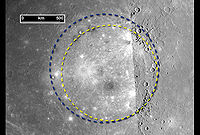 |
|
| Rembrandt Rembrandt (crater) Rembrandt is a large impact crater on Mercury. With a diameter of 715 km it is the second-largest impact basin on the planet, after Caloris, and is one of the larger craters in the Solar System. It was discovered by MESSENGER during its second flyby of Mercury on October 6, 2008. The crater is... |
abbr=on 715 | 15% | 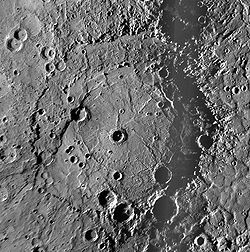 |
|||
| Venus Venus Venus is the second planet from the Sun, orbiting it every 224.7 Earth days. The planet is named after Venus, the Roman goddess of love and beauty. After the Moon, it is the brightest natural object in the night sky, reaching an apparent magnitude of −4.6, bright enough to cast shadows... |
Mead Mead (crater) Mead is an impact crater on Venus named in honor of the cultural anthropologist Margaret Mead.Mead crater is the largest impact crater on Venus, with a diameter of . The crater has an inner and an outer ring and a small ejecta blanket surrounding the outer ring... |
abbr=on 280 | 12,100 | 2% | 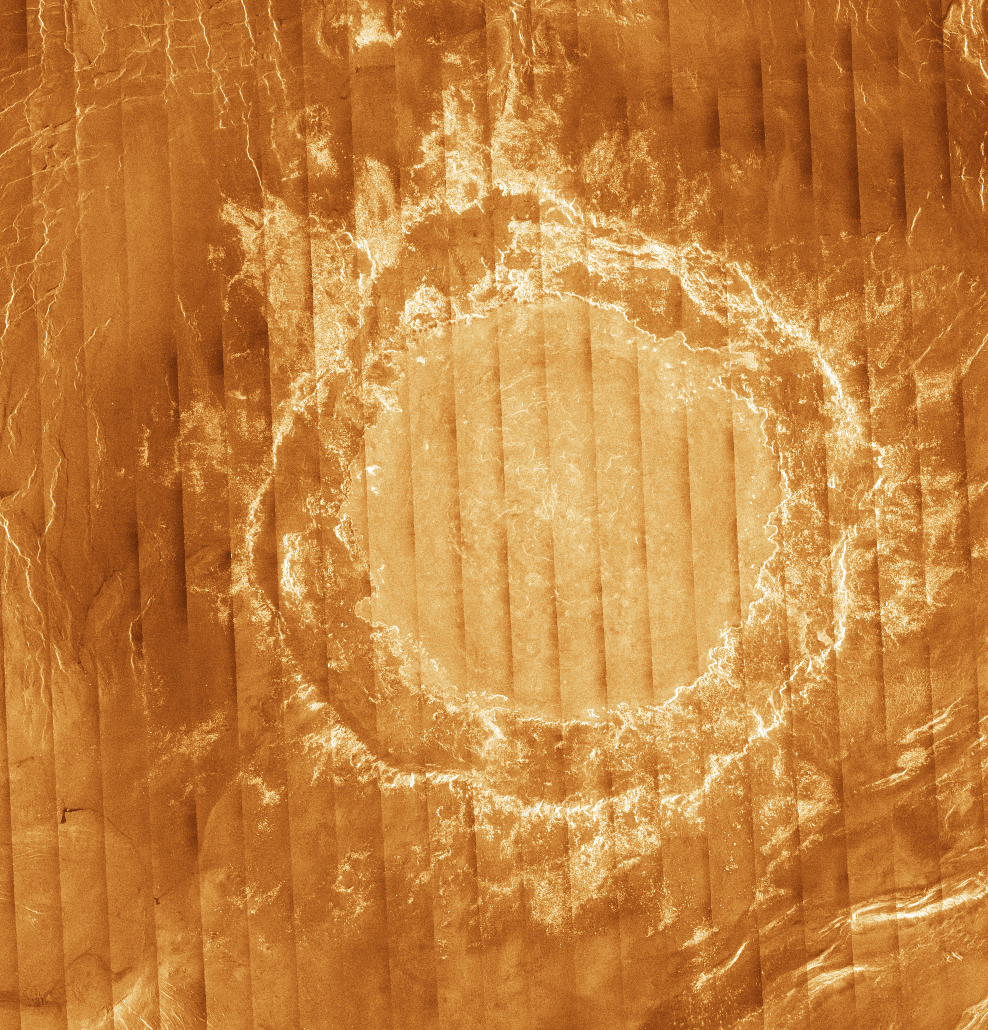 |
|
| Earth Earth Earth is the third planet from the Sun, and the densest and fifth-largest of the eight planets in the Solar System. It is also the largest of the Solar System's four terrestrial planets... |
Vredefort Vredefort crater Vredefort crater is the largest verified impact crater on Earth. It is located in the Free State Province of South Africa and named after the town of Vredefort, which is situated near its centre. The site is also known as the Vredefort dome or Vredefort impact structure... |
250–300 km | 12,740 | 2% | ||
| Moon Moon The Moon is Earth's only known natural satellite,There are a number of near-Earth asteroids including 3753 Cruithne that are co-orbital with Earth: their orbits bring them close to Earth for periods of time but then alter in the long term . These are quasi-satellites and not true moons. For more... |
abbr=on 2500 | 3470 | 70% | |||
| Mare Imbrium Mare Imbrium Mare Imbrium, Latin for "Sea of Showers" or "Sea of Rains", is a vast lunar mare filling a basin on Earth's Moon and one of the larger craters in the Solar System. Mare Imbrium was created when lava flooded the giant crater formed when a very large object hit the Moon long ago... |
abbr=on 1145 | 33% | 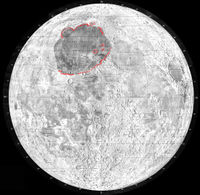 |
|||
| Mars Mars Mars is the fourth planet from the Sun in the Solar System. The planet is named after the Roman god of war, Mars. It is often described as the "Red Planet", as the iron oxide prevalent on its surface gives it a reddish appearance... |
North Polar Basin North Polar Basin (Mars) The North Polar Basin, or Borealis basin, is a large basin in the northern hemisphere of Mars that covers 40% of the planet. Chryse Planitia, the landing site of the Viking 1 lander, is a bay which opens into this basin.... |
10,600 × 8,500 km | 6780 | 140% | 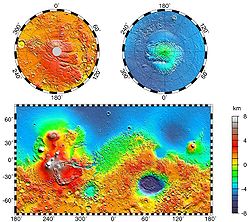 |
Not confirmed as an impact basin |
| Hellas Planitia Hellas Planitia Hellas Planitia, also known as the Hellas Impact Basin, is a huge, roughly circular impact basin located in the southern hemisphere of the planet Mars. It is the second or third largest impact crater and the largest visible impact crater known in the Solar System... |
abbr=on 2300 | 34% | Largest visible crater in the Solar system | |||
| Vesta 4 Vesta Vesta, formally designated 4 Vesta, is one of the largest asteroids, with a mean diameter of about . It was discovered by Heinrich Wilhelm Olbers on March 29, 1807, and is named after the Roman virgin goddess of home and hearth, Vesta.... |
Rheasilvia Rheasilvia Rheasilvia is the most prominent surface feature on asteroid 4 Vesta and is believed to be an impact crater. in diameter, it is 80% the size of the asteroid, making it one of the largest craters in the Solar System, and covers most of the southern hemisphere. It was discovered in Hubble images in... |
abbr=on 460 | 529 | 87% | See also List of tallest mountains in the Solar System | |
| pre-Rheasilvia basin | abbr=on 400 | 75% | ||||
| Ganymede (Jupiter) | Epigeus | abbr=on 343 | 5270 | 6½% | ||
| Callisto (Jupiter) | Valhalla Valhalla (crater) Valhalla is the largest multi-ring structure on Jupiter's moon Callisto and in the Solar System. It was named after Valhalla, Odin's hall in Norse mythology. Valhalla consists of a bright central region 360 km across, an inner ridge and trough zone and striking concentric rings extending up... |
abbr=on 360 | 4820 | 7½% | 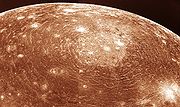 |
|
| Heimdall | abbr=on 210 | 4% | ||||
| Mimas Mimas (moon) Mimas is a moon of Saturn which was discovered in 1789 by William Herschel. It is named after Mimas, a son of Gaia in Greek mythology, and is also designated Saturn I.... (Saturn) |
Herschel | abbr=on 139 | 396 | 35% | 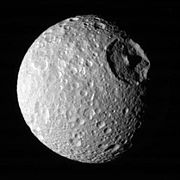 |
See also List of tallest mountains in the Solar System |
| Tethys Tethys (moon) Tethys or Saturn III is a mid-sized moon of Saturn about across. It was discovered by G. D. Cassini in 1684 and is named after titan Tethys of Greek mythology. Tethys is pronounced |Odysseus]] is about 400 km in diameter, while the largest graben—Ithaca Chasma is about 100 km wide and... (Saturn) |
Odysseus Odysseus (crater) Odysseus is the largest crater on Saturn's moon Tethys. It is 445 km across, more than 2/5 of the moon's diameter, and is one of the larger craters in the Solar System. It is situated in the western part of leading hemisphere of the moon—the latitude and longitude of its center are 32.8°N and... |
abbr=on 445 | 1060 | 42% | ||
| Rhea Rhea (moon) Rhea is the second-largest moon of Saturn and the ninth largest moon in the Solar System. It was discovered in 1672 by Giovanni Domenico Cassini.-Name:Rhea is named after the Titan Rhea of Greek mythology, "mother of the gods"... (Saturn) |
Mamaldi | approx. abbr=on 500 | 1530 | 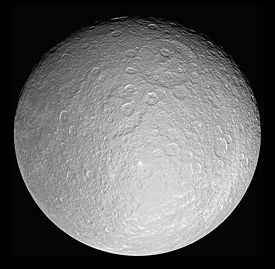 |
||
| Tirawa Tirawa (crater) Tirawa basin is a large impact crater on Saturn's moon Rhea, at . It was glimpsed by Voyager 1 during its flyby of the moon and later photographed in greater detail by the Cassini orbiter.... |
abbr=on 360 | 24% | 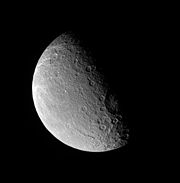 |
|||
| Titan Titan (moon) Titan , or Saturn VI, is the largest moon of Saturn, the only natural satellite known to have a dense atmosphere, and the only object other than Earth for which clear evidence of stable bodies of surface liquid has been found.... (Saturn) |
Menrva | abbr=on 392 | 5150 | 7½% | ||
| Iapetus (Saturn) | Turgis Turgis (crater) Turgis is the largest known crater on Saturn's moon Iapetus. It is 580 km in diameter, 40% of the moon's diameter and one of the larger craters in the Solar System. It is named after a Saracen baron, Turgis of Turtelose .... |
abbr=on 580 | 1470 | 39% | 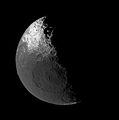 |
|
| Engelier | abbr=on 504 | 34% | ||||
| Gerin | abbr=on 445 | 30% | 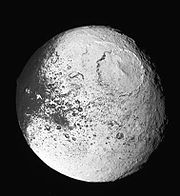 |
Gerin is overlain by Engelier | ||
| Falsaron | abbr=on 424 | 29% | 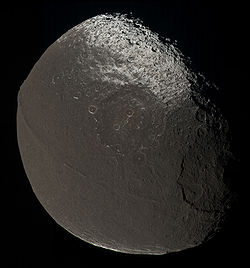 |
|||
| Titania Titania (moon) Titania is the largest of the moons of Uranus and the eighth largest moon in the Solar System at a diameter of 1578 km. Discovered by William Herschel in 1787, Titania is named after the queen of the fairies in Shakespeare's A Midsummer Night's Dream... (Uranus) |
Gertrude Gertrude (crater) Gertrude is the largest known crater on Uranus's moon Titania. It is about 326 km across, 1/5 of Titania's diameter. It is named after the mother of Hamlet in William Shakespeare's play Hamlet. Features on Titania are named after female Shakespearean characters.The crater rim of Gertrude is... |
abbr=on 326 | 1580 | 21% | 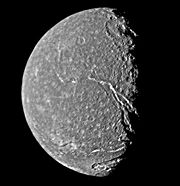 |
Little of Titania has been imaged, so it may well have larger craters. |

